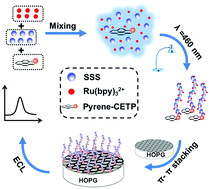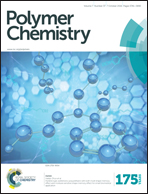Simultaneous utilization of a bifunctional ruthenium complex as an efficient catalyst for RAFT controlled photopolymerization and a sensing probe for the facile fabrication of an ECL platform†
Abstract
Ruthenium (Ru)-complex (Ru(bpy)32+) catalyzed reversible addition–fragmentation chain transfer (RAFT) photopolymerization is an attractive technique for preparing polymer-functionalized biomaterials because of its gentle reaction conditions. Until now, negatively charged polymers prepared by this polymerization method have been seldom reported, which should be due to the difficulty in removing the positively charged catalyst Ru(bpy)32+ from the negatively-charged polymer owing to the strong electrostatic attraction between them. However, the difficulty in removing Ru(bpy)32+ from the negatively charged polymer should not always be regarded as just a shortcoming, on the contrary, it can be utilized as an advantage for developing a stable and efficient solid-state electrogenerated chemiluminescence (ECL) sensor. Herein, pyrene-functionalized poly(sodium p-styrene sulfonate) (PSS) was successfully synthesized by RAFT photopolymerization catalyzed via the Ru-complex based photoredox catalyst (Ru(bpy)32+) under visible light (λ = 460 nm). It turned out to be a well-controlled RAFT polymerization as evidenced by 1H NMR and gel permeation chromatography (GPC) analyses. Based on the stable electrostatic attraction of Ru(bpy)32+ with PSS and a non-covalent π–π stacking interaction between the pyrene moiety and the highly oriented pyrolytic graphite surface, a stable and efficient solid-state ECL sensor was successfully fabricated. The as-proposed sensor was investigated using tripropylamine as a representative analyte and a low detection limit of 0.1 nM (S/N ≥ 3) was reached. It also exhibited excellent reproducibility (relative standard deviations of 0.56% for 112 continuous cycles) and long-term stability (about 90% of its preliminary ECL intensity can be retained after intermittent use over a 90-day period).


 Please wait while we load your content...
Please wait while we load your content...